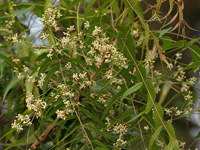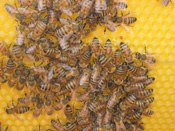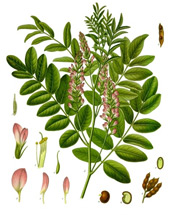The neem tree, a member of the mahogany family, is native to Southeast Asia where it has been known for thousands of years as a medicinal plant, hence its nickname the “pharmacy tree.” Virtually every part of the tree from the seeds to the leaves, oil, bark, roots, flowers and fruit have therapeutic uses; neem is widely used in Ayurvedic medicine. The tree boasts significant anti-microbial, anti-inflammatory and anti-fungal properties, and has a number of uses in oral care, including the treatment of mouth ulcers and gum disease.
Disinfecting and Healing Properties
 Neem is a very well researched herbal remedy. According to the Neem Foundation, the bark, leaves and extract have powerful germicidal action and have the ability to kill dozens of pathogens. Scientists have studied neem’s ability to destroy the strains of streptococcus and staphylococcus bacteria involved with tooth decay. It therefore may be able to help improve oral health and prevent periodontal diseases including plaque, gingivitis, cavities and tarter build-up.
Neem is a very well researched herbal remedy. According to the Neem Foundation, the bark, leaves and extract have powerful germicidal action and have the ability to kill dozens of pathogens. Scientists have studied neem’s ability to destroy the strains of streptococcus and staphylococcus bacteria involved with tooth decay. It therefore may be able to help improve oral health and prevent periodontal diseases including plaque, gingivitis, cavities and tarter build-up.
Traditional Uses
Neem is very popular for skin care and for treating skin disorders. Traditionally it has been used for healing wounds as well as for treating skin bacterial and fungal infections. It is often used in soaps to relieve redness and soothe and moisturize dry, itchy or cracked skin, as well as in shampoos for treating dandruff and dry scalp. It is also a safe and natural pesticide and insect repellant.
Oral Care
Historically, people in India used neem as a natural toothbrush. They broke off a twig and chewed on it to keep their teeth clean and prevent gum disease. In the west, neem is sometimes added to toothpaste. Its potent anti-inflammatory and anti-bacterial action may help relieve canker sores and the pain and the swelling and inflammation of gingivitis. Some people find it improves their breath and leaves their mouth with a feeling of cleanliness.
Topical Remedy
Neem Oil
is known as the “oil of wonder” for its healing and skin rejuvenation qualities. Unfortunately has a very strong odor that most people do not like. To be blunt, it stinks. Thus it is frequently masked with other pleasant smelling oils when used in skin or hair products. However, you can buy the straight oil, which is best when using it for healing. Although it also tastes nasty, neem oil dabbed on sore gums or the inside of the cheek or lips can aid in healing your ulcer (but the oil should not be swallowed).
You can also make a quite effective topical remedy for your canker sore using aloe vera and neem harnessing the aloe’s soothing and healing qualities and neem’s antiseptic benefits. Mix about a teaspoon of pure aloe vera gel – make sure it is pure without additives that could cause irritation – with about 1/8 tsp of need powder and dab it directly to your sore.
Neem Toothpaste
Neem toothpaste is a great option for people plagued with mouth sores or periodontal disease. Regular use may help repair tissue or even help prevent new mouth sores. Neem-based toothpastes you may want to try include:
- Theraneem Organix Herbal Neem Toothpaste
- Desert Essence
- Neem & Pomegranate Toothpaste
- Dabur Herbal Neem Toothpaste
- Ayucare
- Auromere
Look for a toothpaste that uses the bark, as it contains a higher concentration of chemical compounds than the leaves and it’s less bitter. Also, be sure the product does not contain sodium laurel sulfate, as that could aggravate your mouth ulcers. As mentioned, neem does not taste very nice, but the toothpastes contain ingredients to make the products more palatable.
Tea
Another option is to prepare neem tea with the dried or fresh leaves to use as a mouthwash to relieve canker sore pain. Steep two or three whole neem leaves in a cup of water. Since neem is very bitter, you will definitely want to sweeten it with honey or stevia!
Where to Buy It
You can find neem in a variety of forms including powder, extract, gel, cream and juice, as well as whole leaf, at health food stores and on Amazon.
Resources:




